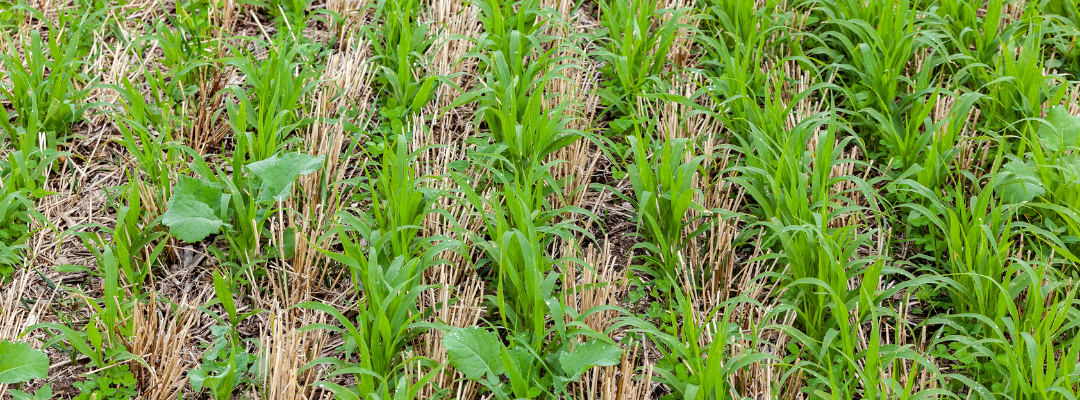Large-scale ecosystem benefits tend to drive policy interest in cover crops. However, incorporating cover crops in a farm management plan will also require them to generate on-farm returns. To date, findings of their ability to generate profits have been mixed with inconsistent results across several studies. However, returns in a broad sense of cover crops include potential impacts on risks in addition to their effect on profits. A year of substantial loss savings can offset or justify years of minimal to slightly decreased net profit outcomes. Especially true in areas where crop prices are countercyclical to yields. Therefore, if or how cover crops help manage risk is an important consideration for their inclusion in a farm management plan.
Cover crops and their ability to reduce soil erosion and provide increased root infiltration into the soil have been studied in the context of managing specific risks, extreme wet and extreme dry (drought) conditions. Roughly 83% of total crop insurance losses in the Mid-South were related to one of these two events with 70% being excess moisture related and the majority of those from prevented planting. Regarding extreme moisture risks, most studies indicate that cover crops reduce crop damage under specific conditions. Where nutrient leeching is an issue, which may be a feature on some irrigated fields, cover crops, particularly grass cover crops, have been found to reduce corn yield losses during extreme moisture events because of higher available carbon during the growing season. A study in Northeast Mississippi showed reduced effects of excess moisture in corn-soybean rotation fields. However, some studies also show that cover crops can create early season planting challenges getting the cash crop planted in wet fields. The additional time required to terminate the cover crop may not allow sufficient time to get the cash crop planted and established. This is especially true in conventional tilling systems and where planting green (planting the cash crop in a living cover crop) is not possible.
In NRCS Zone 4 cover crop regions, the effects of cover crops in drought conditions seemed to be more consistent. The findings suggest that cover crops reduced soil compaction, increased root infiltration, and in general, led to increased water availability for the cash crop, reducing drought damage. More studies are needed in the mid-south, but a few studies observing farmers in the Midwest during the 2012 drought saw farms with cover crops experiencing an eleven (11) percentage point increase in yields relative to farms without cover crops.
Overall, cover crops show potential for risk management, particularly for managing drought risk. However, outcomes appear to be highly related to the suite of management practices on the farm, such as the cover crop variety used, whether combined with no-till, the ability to plant green, and the planting dates of the cash crop in question. In the mid-south, a cover crop before planting cotton or soybeans may be more feasible than a cover crop before planting corn when considering planting dates and early season weather risks. Nevertheless, where risk management rather than yield is the goal, a conversation with a local agronomist may help determine whether cover crops may be a good consideration as a long-term risk management tool on your farm.
Mid–South Causes of Indemnities Crop Insurance: 2015 – 2020

References:
Bergtold, J., Ramsey, S., Maddy, L., & Williams, J. (2019). A review of economic considerations for cover crops as a conservation practice. Renewable Agriculture and Food Systems, 34(1), 62-76. doi:10.1017/S1742170517000278
Bharat Sharma Acharya, Syam Dodla, Lewis. A. Gaston, Murali Darapuneni, Jim J. Wang, Seema Sepat, Hari Bohara, Winter cover crops effect on soil moisture and soybean growth and yield under different tillage systems, Soil and Tillage Research, Volume 195, 2019, 104430, ISSN 0167-1987, https://doi.org/10.1016/j.still.2019.104430
Blanco-Canqui, H., Shaver, T.M., Lindquist, J.L., Shapiro, C.A., Elmore, R.W., Francis, C.A. and Hergert, G.W. (2015), Cover Crops and Ecosystem Services: Insights from Studies in Temperate Soils. Agronomy Journal, 107: 2449-2474. https://doi.org/10.2134/agronj15.0086
Chalise, K.S., Singh, S., Wegner, B.R., Kumar, S., Pérez-Gutiérrez, J.D., Osborne, S.L., Nleya, T., Guzman, J. and Rohila, J.S. (2019), Cover Crops and Returning Residue Impact on Soil Organic Carbon, Bulk Density, Penetration Resistance, Water Retention, Infiltration, and Soybean Yield. Agronomy Journal, 111: 99-108. https://doi.org/10.2134/agronj2018.03.0213
G.S. Marcillo and F.E. Miguez, Corn yield response to winter cover crops: An updated meta-analysis, Journal of Soil and Water Conservation May 2017, 72 (3) 226-239; DOI: https://doi.org/10.2489/jswc.72.3.226
Connor, Lawson. “Cover Crops and Risk“. Southern Ag Today 2(34.3). August 17, 2022. Permalink

